Music was an essential part of Roman life, shaping various aspects such as festivals, religious rituals, and social status. Its influence extended into different areas of Roman life, including religious practices, which were not just a set of beliefs but a comprehensive system intertwined with every aspect of their lives. This connection is evident in the way music played a role in festivals, enhancing the celebratory atmosphere. Additionally, music also reflected and influenced social status within society.
The agricultural sector also played a crucial role in Rome’s economic growth, which in turn influenced cultural aspects including music. Understanding this multifaceted role of music provides valuable insight into the complexities of Roman society, from its birth as a republic to its expansive reach across different domains.
Musical Instruments in Ancient Rome
Roman music relied on a diverse collection of instruments, each contributing unique sounds suited to different occasions. These instruments reveal much about Roman culture and the contexts in which music thrived.
Key Roman instruments included:
- Tibia: A double-reed woodwind instrument resembling a modern oboe. The tibia produced a penetrating, nasal tone and was widely used in religious ceremonies and theatrical performances.
- Aulos: Borrowed from Greek tradition, the aulos was a reed instrument often played in pairs. Its sharp, vibrant sound accompanied festivals and military events.
- Tympanum: A handheld frame drum, the tympanum provided rhythmic support in both sacred rituals and popular entertainments.
- Lyre: A stringed instrument associated with poetic recitations and private gatherings. The lyre’s delicate melodies were ideal for storytelling and intimate performances.
- Cornu: A large curved brass horn used primarily in military signals and public ceremonies. Its deep, resonant tone commanded attention across open spaces.
- Tuba: Different from modern tubas, this straight bronze trumpet emitted bold, bright sounds for announcements during games and triumphs.
- Hydraulis: An early water-powered pipe organ capable of producing sustained tones. The hydraulis was a technological marvel employed in large-scale spectacles to add grandeur.
- Cymbals: Percussion instruments that created sharp crashes to punctuate dramatic moments or enhance rhythmic complexity.
- Other percussion instruments: Various rattles, clappers, and tambourines added texture and lively accents to musical ensembles.
The varied tonal qualities of these instruments allowed Romans to tailor their soundscape according to setting:
Religious ceremonies favored the hypnotic drone of reed instruments paired with rhythmic drums to evoke spiritual presence.
Theatrical performances integrated wind and string instruments to heighten emotional expression, showcasing the importance of theater in ancient Rome.
Public games relied on the brilliance of brass horns like the cornu and tuba to energize crowds.
Private banquets often featured softer sounds from lyres creating an intimate atmosphere.
Roman musicians mastered blending these timbres into complex arrangements serving social, religious, or entertainment purposes. The rich palette of instruments mirrored the complexity of Roman life itself. This complexity is further reflected in the daily life of its citizens, particularly the plebeians, whose experiences significantly influenced social dynamics. Additionally, the artistic expressions seen in Roman art also provide insight into this intricate society.
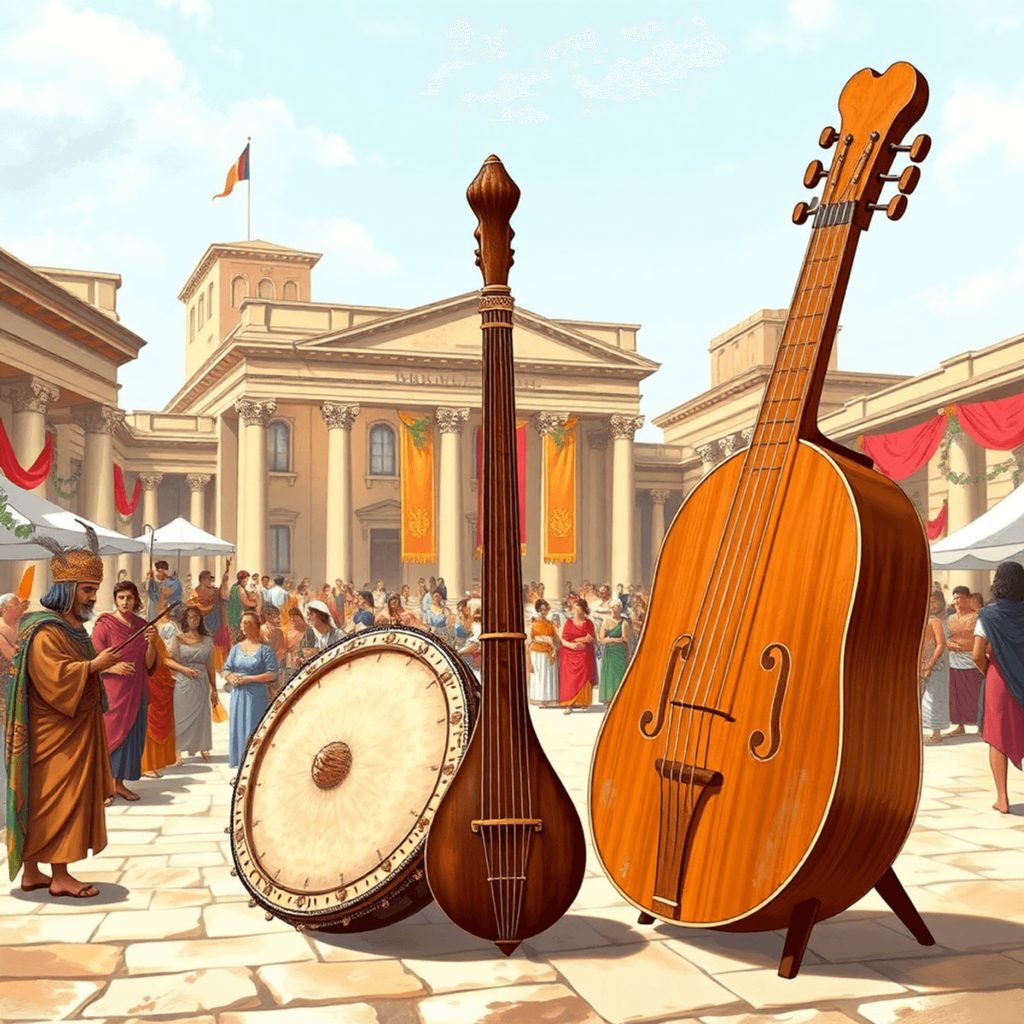
The Vibrant World of Roman Festivals and Musical Performances
Music played a central role in the lively atmosphere of Roman festivals, enriching the cultural tapestry of the ancient society. Here’s a closer look at the dynamic interplay between music and public celebrations in Rome:
1. Importance of Musical Performances
Music was an integral part of Roman festivals, enhancing the overall experience for participants. Whether religious, civic, or entertainment-focused, these events were incomplete without musical accompaniment. The sounds of various instruments added depth and emotion to the festivities, creating a vibrant ambiance that captivated attendees.
2. Incorporation of Music in Public Games and Theatrical Performances
Public games and theatrical performances were popular forms of entertainment in ancient Rome, drawing large crowds eager for spectacle and excitement. Music was seamlessly woven into these events, heightening dramatic tension, evoking emotions, and amplifying the theatrical experience. Greek musicians often graced these occasions with their talent, bringing their unique style and expertise to Roman audiences.
3. Influence of Greek Musicians on Roman Festivals
The presence of Greek musicians in Roman festivals significantly impacted the musical landscape of the time. Their artistic contributions infused new energy and innovation into Roman music, enriching it with diverse styles and techniques. Greek influences shaped the development of musical performances in Rome, leaving a lasting imprint on the cultural heritage of the empire.
The vibrant world of Roman festivals and musical performances served as a platform for artistic expression, community engagement, and cultural exchange. Through music, these events transcended mere entertainment to become transformative experiences that reflected the rich tapestry of Roman society.
Moreover, these festivals were not only about music but also intertwined with various aspects of Roman life including law, philosophy, military might, infrastructure and engineering feats. For instance, the Twelve Tables, a significant milestone in Roman law created between 451-450 BCE, marked an important evolution in legal practices during this period.
Simultaneously, Stoicism, a philosophical school founded by Zeno of Citium around 300 BCE in ancient Greece also gained popularity in Rome during this era. Its main principles emphasized living in harmony with nature using reason and practicing virtue as paths to achieving eudaimonia or human flourishing.
In addition to this cultural exchange through music and philosophy, the Roman army, known for its military power played a crucial role in expanding the empire while Roman roads served as vital links maintaining effective governance and cultural exchange across vast territories.
Furthermore, Roman engineering feats such as aqueducts and monumental buildings not only showcased their architectural prowess but also significantly influenced contemporary infrastructure systems.
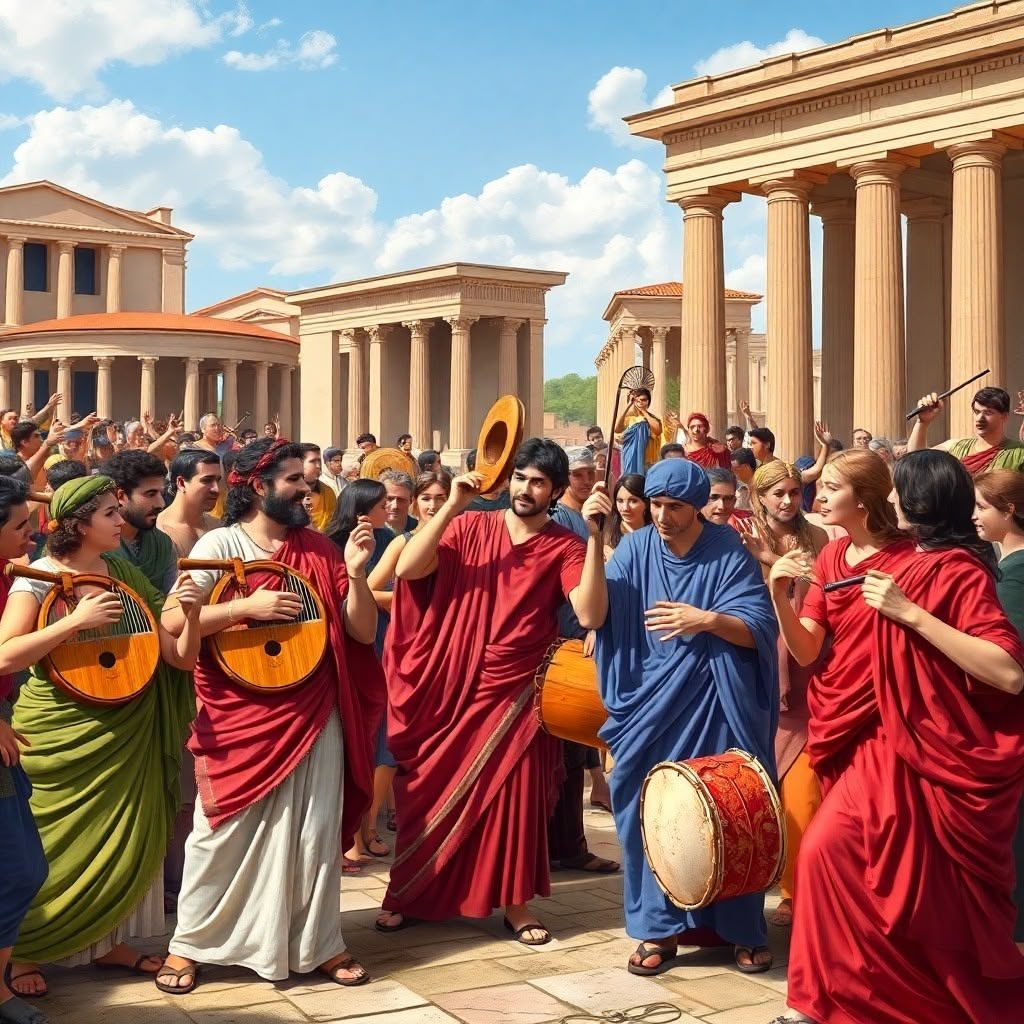
The Sacred Soundscape: Music’s Role in Religious Rituals
Music played a significant role in the religious ceremonies of ancient Rome. It wasn’t just background noise; it was an essential element used to call upon the gods and create a sacred bond between worshippers and the divine. The combination of various instruments, singing, and hymns produced a powerful spiritual atmosphere that enhanced the rituals.
Key elements of music in Roman religious rituals included:
- Invocation and Praise: Priests and participants used song and instrumental music to call upon deities, praising their power and seeking protection or blessings.
- Instrumental Soundscapes: The tibia (double-reed flute), cornu (horn), and tympanum (drum) were commonly played during sacrifices and temple ceremonies. Their distinct tones symbolized different divine attributes or phases of the ritual.
- Chanting and Hymns: Collective chanting formed an essential part of ceremonies, uniting participants in devotion. Hymns often combined poetic verses with melodic recitation, enhancing memorability and emotional resonance.
- Ritual Timing: Music marked specific moments such as the beginning of sacrifices, processions, or the conclusion of prayers, structuring the flow of sacred events.
Roman religion emphasized sensory experience; music intensified these moments by engaging attendees beyond sight and speech. It helped establish a solemn mood while signaling transitions within complex rituals. This use of sound fostered communal participation, reinforcing social cohesion mediated through shared spiritual expression.
The relationship between music and religion in Rome also reflected broader cultural exchanges. Influences from Etruscan rites and Greek sacred music enriched Roman ceremonial practices, introducing new instruments like the hydraulis (water organ) into temple settings.
Understanding this sacred soundscape highlights how intertwined music, religion, and society were—each amplifying the other’s significance in Roman life.
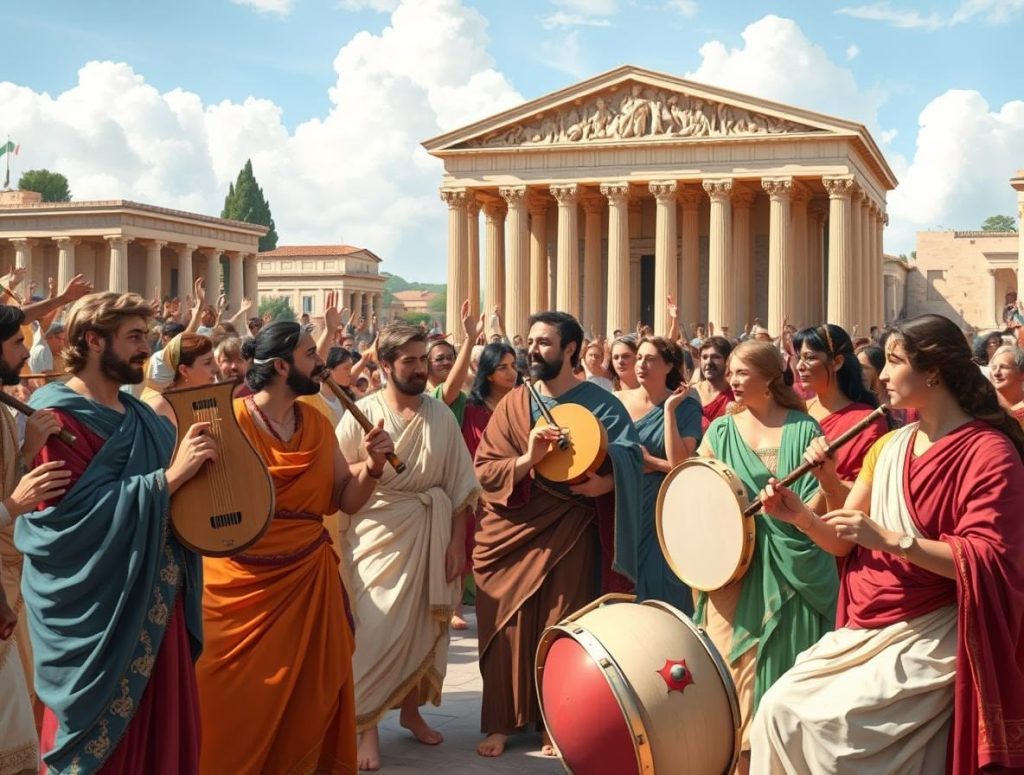
Music as a Marker of Social Status in Roman Society
In ancient Rome, music served as a powerful marker of social status, particularly among the aristocracy. Here is an exploration of the symbolic significance of music in Roman society:
1. Aristocratic Symbolism
Music was not only a form of entertainment but also a symbol of sophistication and cultural refinement among the Roman elite. The ability to appreciate and patronize music was seen as a mark of high social standing.
2. Sponsorship and Patronage
Wealthy aristocrats often sponsored musicians and musical performances as a way to showcase their affluence and discernment in the arts. This sponsorship was not only a display of wealth but also a means of cultural expression and influence within Roman society.
3. Social Perceptions of Female Musicians
While female musicians were respected for their talents, their roles were subject to social nuances. In some cases, female musicians were celebrated for their artistry, yet there were societal expectations and limitations placed on their participation in public performances. These limitations reflect the broader legal status of Roman women, which was marked by a complex interplay of rights and restrictions significantly influencing gender dynamics in ancient Rome.
Music, therefore, played a dual role in Roman society—acting as both a form of entertainment and a significant marker of social distinction. The aristocracy’s association with music not only elevated their social status but also contributed to the cultural vibrancy and refinement that characterized Roman society. This cultural richness was mirrored in various aspects such as gladiatorial games, where music often accompanied these events, further intertwining the realms of entertainment and social status.
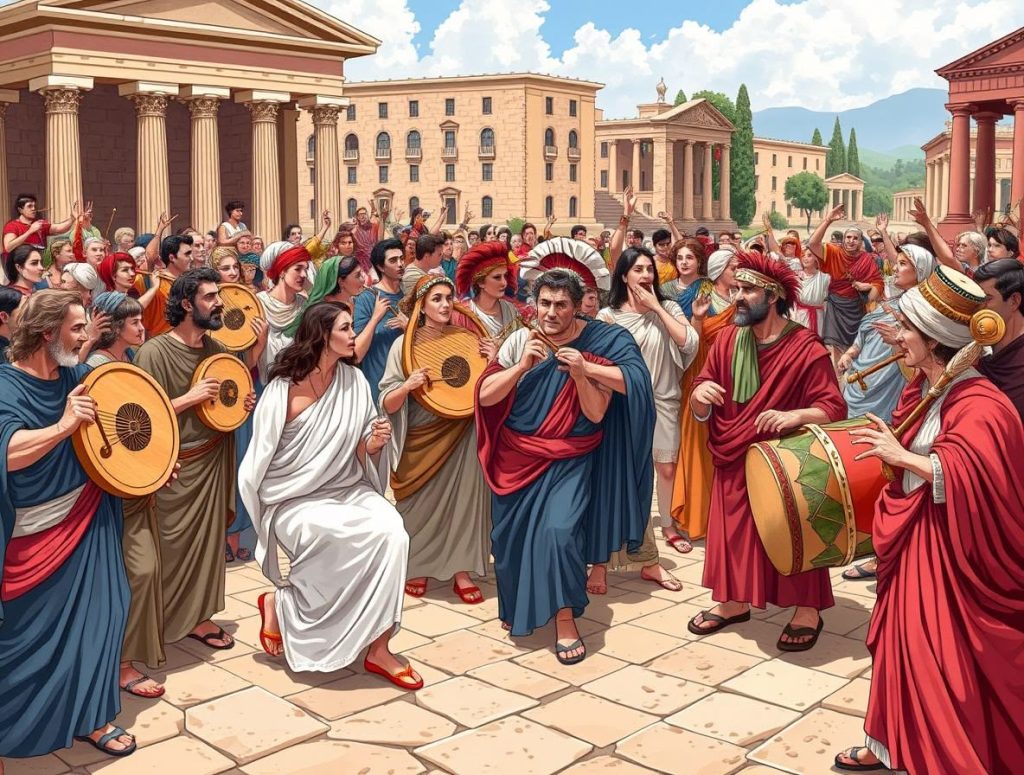
Amateur and Professional Musicians: A Diverse Musical Culture in Rome
Music played a vital role in both public and private life in ancient Rome, as explored in various studies such as this one on Exploring Ancient Rome. It was an essential part of community celebrations like festivals, weddings, and important rituals, where amateur musicians often joined in with professionals. These events provided opportunities for people to connect socially and express their culture, combining music with dance, poetry, and storytelling.
Music in Public Celebrations
- Festivals: Music was an integral part of various Roman festivals, such as the Lupercalia and Saturnalia, where both amateur and professional musicians would perform.
- Weddings: Musical performances were common during wedding ceremonies and receptions, with family members or hired musicians entertaining guests.
- Rites of Passage: Significant life events like coming-of-age ceremonies or funerals often included musical elements to enhance the emotional atmosphere.
Music in Private Gatherings
- Banquets: Wealthy households hosted lavish banquets where musicians would be invited to play, showcasing their status and providing entertainment.
- Family Gatherings: In more intimate settings, family members would come together for celebrations or memorials, using music as a way to bond and remember loved ones.
The impact of music extended beyond mere enjoyment; it served as a tool for strengthening relationships within families and communities.
The Role of Professional Musicians
While amateur musicians played an important role in these contexts, professional musicians also held significance within Roman society. Their position was often complex:
- Craftsmen vs. Artists: Professional musicians were typically seen as skilled craftsmen rather than revered artists, with their worth measured by technical proficiency rather than creative expression.
- Contextual Variations: The status of professional musicians could vary depending on the context—public performers at festivals might gain recognition while those attached to aristocratic households enjoyed higher prestige through association.
- Blurring Boundaries: Some professional musicians were slaves or freedmen trained for specific roles, highlighting the blurred lines between servitude and artistic skill.
Despite occasional social stigma attached to being a musician—a profession sometimes associated with lower classes—these individuals contributed significantly to the cultural vibrancy of Rome. Their presence was essential at various public events such as gladiatorial games, triumphal processions, religious ceremonies (including sacrifices), theatrical performances (both comedies and tragedies), etc., where music played an integral part.
The diversity of musical culture reflected Rome’s multifaceted society—one that encompassed different classes yet also reinforced them through its artistic expressions.
This rich musical heritage is deeply intertwined with the broader cultural fabric of ancient Rome which includes influences from Roman mythology that continue to resonate in modern culture.
The Enduring Legacy of Roman Music
Reconstructing the musical traditions of ancient Rome relies heavily on two primary sources: literary descriptions and archaeological findings. Roman writers like Cicero, Ovid, and Pliny the Elder provide detailed accounts of musical instruments, performances, and the societal roles music played. These texts reveal not only technical aspects but also the emotional and cultural significance Romans attributed to music.
Archaeological discoveries have unearthed a variety of instruments—such as fragments of lyres, pipes, and brass horns—offering tangible evidence that complements historical writings. Reliefs, frescoes, and mosaics depict musicians and musical scenes, enriching our understanding of performance contexts and instrument design. Together, these sources enable scholars to piece together how Romans produced sound and integrated music into everyday life.
The cultural significance of Roman music extends beyond Italy. Its influence permeated the Mediterranean basin through trade, conquest, and cultural exchange. Roman musical practices absorbed elements from Greek traditions while also impacting neighboring regions. This cross-pollination helped shape the broader musical landscape of antiquity.
Studying The Role of Music in Roman Society—Instruments, Performances, Festivals highlights how ancient Roman music contributed to social cohesion, religious expression, and entertainment across diverse communities. Tracing this legacy deepens appreciation for the complexity and reach of Roman culture within the ancient world.
Furthermore, the influence of notable figures such as Scipio Africanus during pivotal moments like the Second Punic War also played a role in shaping Roman culture and its music. His military strategies not only changed the course of history but also reinforced Rome’s dominance in the Mediterranean region. Understanding these historical contexts enriches our comprehension of Roman Architecture, Roman Law, and the lifestyle of Patricians, who were masters of luxury and power in ancient Rome.
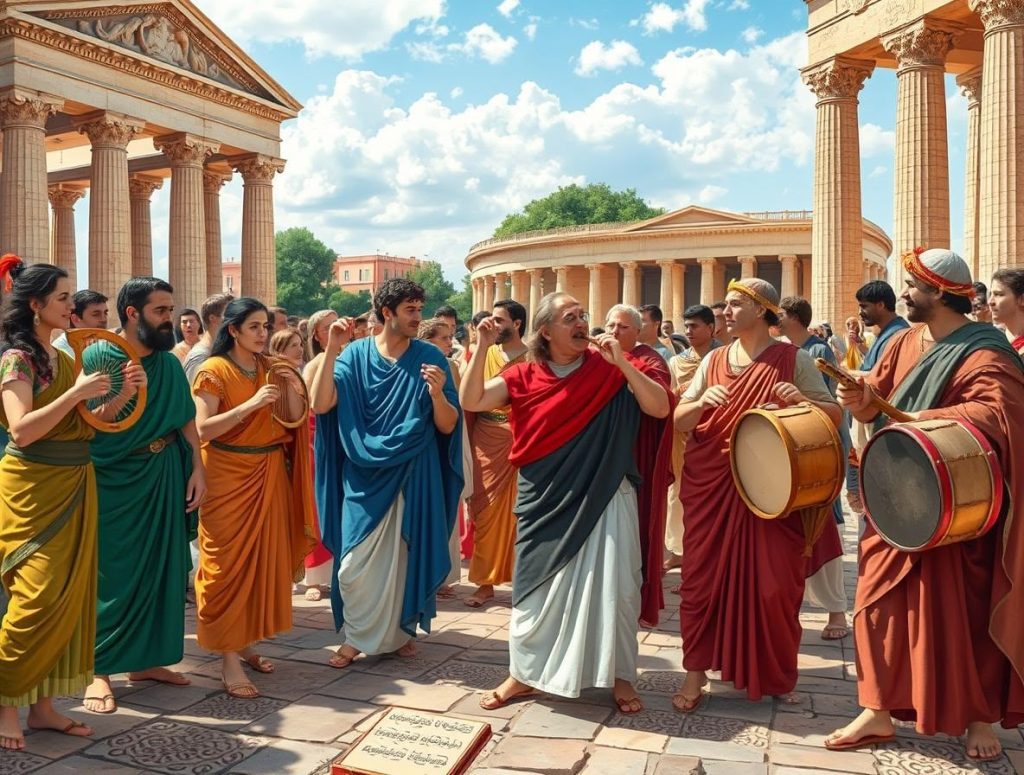
Conclusion
Roman music has left a lasting impact on society, intertwining with every aspect of Roman life.
The enduring legacy of music in Roman society highlights its profound influence on cultural, religious, and social spheres.
From religious ceremonies to public festivals and social gatherings, music was an essential element that shaped the Roman experience.
It acted as a unifying force, reflecting the richness and diversity of Roman culture through its melodic tapestry.
The role of music in Roman society stands as a testament to its power in bringing communities together and shaping identities over centuries. This influence is part of a larger story about the legacy of Ancient Rome, which remains a cornerstone of Western civilization.
The rise and fall of the Roman Empire spanned over a thousand years, leaving an indelible mark on the world, shaping politics, culture, and society in ways that still resonate today.
Moreover, the enduring influence of the Corpus Juris Civilis, commissioned by Emperor Justinian I in the 6th century AD, serves as a significant achievement in legal history. It preserved ancient Roman legal principles while adapting them to contemporary needs, marking a crucial turning point in the development of legal systems, especially in Europe.

